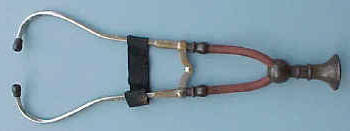The evidence that army physicians
during the Civil War knew how to use a stethoscope can be found in
numerous reports in the Medical and Surgical History of the War of the
Rebellion. They are brief summaries, but with enough detail to know that
physicians were skilled at physical examination.
Some examples:
"Case 4, Regimental
Register, 28th Mass. April 11, 1863...dullness over left nipple;
crepitant rÔles distinct...14th: rubbing sound heard over upper part of
left thorax, rÔles below and dulness overall...17th...no rubbing sound,
dullness less marked...26th...Sent to general hospital to-day."
"Case 9,
from Third Division Hospital, Alexandria, VA: "Diminished resonance over
right side anteriorly with subcrepitant ronchus [sic] below...""Case 10,
Ladies' Home Hospital, New York City:...dullness posteriorly over the
upper portion of the lower lobe of the left lung with feeble respiratory
murmur and moist bronchial rÔles..

Cammann's
Stethoscope above in this
collection is
the exact one shown in Tiemann's 1870's catalog with elastic
band

Also see the 1866
Gemrig catalog on this website with drawings of a
Cammann's stethoscope listed on page 12
Miscellaneous
Instruments
|
The stethoscope is needed to hear
rales and rhonchi, and to detect a 'feeble respiratory murmur'. Notably,
the findings were used to determine the specific location of the
pathology in the lung and it is described in many of these case reports.
In fatal cases the findings on physical examination were verified by the
autopsy findings. Today physicians would rarely try to define the
anatomic location of lung pathology without first seeing a chest x-ray.
In other cases, the description of the examination of the heart mentions
murmurs and friction rubs, which are heard only with the stethoscope.
Note also in the cases listed above that the use of the stethoscope and
other techniques of the physical examination which originated in Europe
was widespread among the military units; it is documented in regimental
and divisional field hospitals, as well as general hospitals.
The regimental surgeons in the field
thus were skilled in the use of the stethoscope, not only specialists in
the cities. Ladies' Home Hospital was a general hospital of 263 beds
(according to the Surgeon General's annual report of 1862) and would be
expected to have specialists in New York City functioning as contract
physicians. It was on Lexington Avenue at the corner of 51st Street;
initially all soldiers from the NYC area who needed trusses were sent
there. This hospital was sometimes called the "Soldier's Home."The use
of percussion, another component of the technique of physical
examination, is documented by the descriptions of dullness and
diminished resonance in these case reports. A statement attributed to
General Robert E. Lee when he had the first of several illnesses during
the war, describes what it felt like to be examined by percussion. His
physicians, he said, were "tapping me all over like an old steam-boiler
before condemning it."3
1 Holmes, Oliver
Wendell. Poems. Boston: Tickner, Reed, and Fields, 1853.2
Barnes, Joseph K. Medical and
Surgical History of the War of the Rebellion. Washington:
Government Printing Office, 1883. Medical Volume 3.3
Foote, Shelby. The Civil War, A
Narrative. New York: Random House, 1958, Vol. II, p 248.4
Dr. Bollet has written an excellent book on Civil War surgery